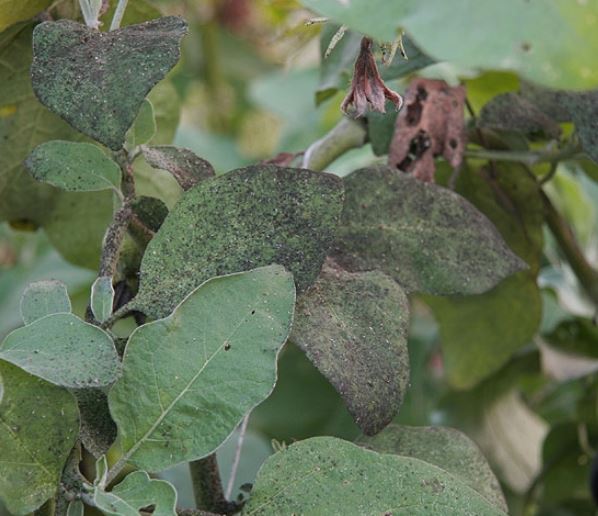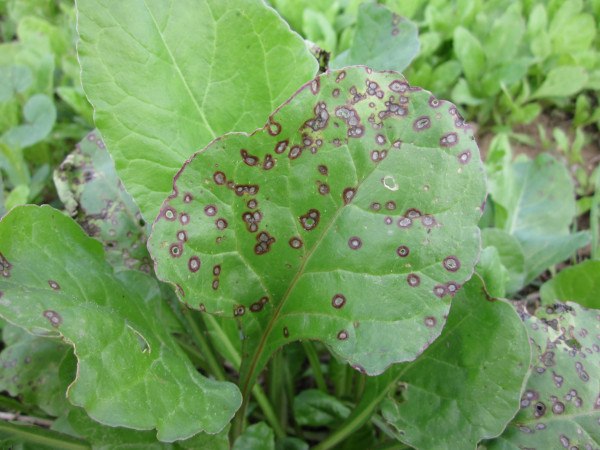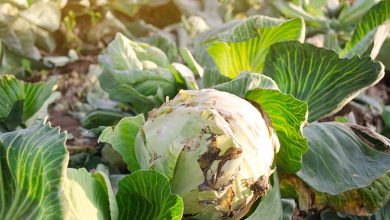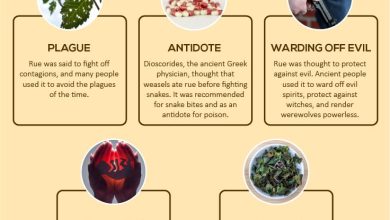Black Spots on Plant Leaves: Find out what it is

Hello to all agrohuerters! In today’s article we will see different examples of why plants have black dots on their leaves. Who is to blame? Can leaf spots be removed? Are they dangerous to plants?

Black dots that are growing: Alternaria
We’re going to start by looking at a fungal disease called Alternaria. Alternaria is an ascomycete fungus, a plant pathogen. The first symptoms of this disease are what you can see in the photo. However, little by little these black dots on the leaves increase.
There are a lot of different species of alternaria so they can attack a wide variety of crops. For example, some of the most affected plants are: tomato, parsley, roses, carrots, tobacco, cabbage, wheat, etc. They say that 20% of the losses in agriculture are due to attacks of this disease.
Here you can see the first symptoms of Alternaria on a tobacco leaf:

Black dots on the leaves: Cercosporiosis
Let’s continue with another fungal disease: Cercosporiosis. In this case the points do not increase their size as much, unlike in the previous case. Although if the infection is very strong, some points can join with others. They usually affect the oldest leaves of the plant but also the rest of the aerial organs.
A high temperature (between 25-30 degrees) and high humidity are the ideal conditions for the development of this disease.
Some general tips to avoid the appearance of this type of disease are:
- Use of resistant varieties
- Dispose well of the remains of the previous crop if it was also infected by the disease.
- Carry out crop rotations (with crops that are not susceptible to being attacked by this disease).
- Or use home methods to prevent its appearance such as those you can see in the following article: Homemade fungicides for plants.
Here is a picture of the symptoms of this disease:

Black, raised spots on leaves: Rust
If we see many small black dots on the leaves that are bulging but it is not an insect, it is most likely that our plants have Rust.
La Roya is present throughout the country. For its development it needs mild temperatures and very high humidity. For this reason, it usually appears after long periods of abundant rain. This disease can cause significant defoliation in plants.
First of all, circular spots of at least 1 mm in diameter appear on the leaves. Later, tan-colored pustules are observed and, in later stages, black-colored pustules appear on the stems and leaves of affected plants.
Below you can see in the photo I took one day in the laboratory these black pustules of Roya:

Black bugs on leaves: Black aphid
I advise you that the first thing we have to do when we see something strange in our plants is to differentiate whether it is a pest (insects or mites) or a disease (fungi, viruses, bacteria). In most cases it will be very easy to see. We will simply observe if they have legs, wings, etc.
In this case we are faced with the case of the black aphid. The black aphid is scientifically known by the name of Aphis fabae since it mainly affects the fabaceas. For example to beans, broad beans, etc. They are usually mainly on the underside of the leaves. They feed on the sap of plants and can transmit viruses by biting them.
In addition, they excrete a sugary liquid that ants love, which can be the cause of the appearance of a disease caused by a fungus known as sooty mold or sooty mold. We will talk about him later.

How to remove black aphids from plants
Among the many methods that exist to eliminate black aphids, the following stand out:
- Soapy solution: It is indeed one of the easiest and most effective methods used in the garden. We simply have to dilute a tablespoon of neutral soap in a liter of water and spray.
- Infusion of garlic or onion: In both cases, boil the garlic (5 cloves for 30 minutes) or the onion (1 onion for 5 minutes) per liter of water. Let cool, strain and spray on plants.
- Other methods against aphids such as neem oil, horsetail or tansy.
Black dots on the leaves: Sooty mold or bold
As we have said before, aphids can indirectly cause the appearance of diseases caused by fungi, such as sooty mold or sooty mold. However, the sugary secretions of other insects such as whiteflies can also attract this type of fungus.
Just as aphids attack many different plants, sooty mold can infect many types of crops. If the attack is very strong, it can affect the photosynthesis of the plant and reduce its growth.
Control methods for this disease are based on controlling the pests that cause it. That is, control aphids, whitefly, cochineal, etc.
Once the plant is infected by this fungus, it is recommended to prune the most affected parts to prevent its spread to the rest of the plant.

If you are left wanting more, you can consult the article on white spots on plant leaves.
References
- Ibbotson, A. (1966). Aggregation in Aphis fabae scop. II. Visual components, Animal Behaviour, 14, 251-260.
- Ministry of Agriculture, Livestock and Food of Guatemala. Fight against Rust. Retrieved on January 19.
- Board of Andalusia. Cercospora. Alert network and phytosanitary information. Ministry of Agriculture and Fisheries. General direction of agricultural and livestock production.
This is all for today, I hope you liked the article about black spots on the leaves of garden plants. If you have doubts or if you want to tell us about your experiences with these diseases, you can do so in the comments. We will be happy to answer.



![Photo of How to Plant Broad Beans in your Garden: Complete Guide in [12 Steps]](https://www.complete-gardening.com/wp-content/uploads/2022/08/how-to-plant-broad-beans-in-your-garden-complete-guide-in-12-steps-390x220.jpg)